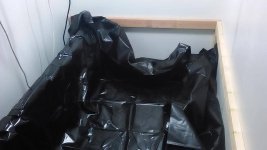Milky, she's a great indoor plant. Can be chopped in under 7 weeks in my set up. Such good herb for anything active, too much at night will keep you up though.
In 2012 I used a shit ton of gypsum to get my Calcium up to around 70%, but my Sulfur also went up to 1000+ppm. I did not see any adverse effects. Also, I think it was in The Ideal Soil somewhere where Michael states that micronutrient sulfates work well in soils already high in Sulfur. Could be in a different book though.
Some plants had their second cut on Nov 2nd. It has to do with dissolved solids. Adequate nutrient levels = high brix = more sugar/antifreeze. K is the sugar mover though...
Organics can be cheap. All the soil amendments I used this year were (seed meals, chicken shit, lime, micro sulfates). I spent less than $50 on insecticides/fungicides (Bt for caterpillars and sea shield for beefing up the plants in anticipation of wet weather accompanied by botrytis). I think if I spent that money on bottled N it would be a 10X bill.
Fwiw I wasn't entirely organic. I used about a quarter gallon of this stuff called N-pHuric acid to decompose bicarbonate ions in the well water and I also did small doses of P acid through the drip every two weeks. I'd say though that 95% of the food was supplied by organic inputs.
Does anyone see a problem with using a touch over whats recommended sulphur wise? I think I'm gonna reammend my OD soil with gypsum, Zn/Cu/Mn sulfates. Last go around my sulphur was low and P was way to frickin high. May have even been a fungi inhibitor.
Tried firing up the mantis yesterday and one of my guys didn't notice the air cleaner was loose. There's soil all up in there. Kinda disappointed about that, looks like I'll be getting a workout instead
In 2012 I used a shit ton of gypsum to get my Calcium up to around 70%, but my Sulfur also went up to 1000+ppm. I did not see any adverse effects. Also, I think it was in The Ideal Soil somewhere where Michael states that micronutrient sulfates work well in soils already high in Sulfur. Could be in a different book though.
Thanks. Follow up question, were you guys able to go into late November And in your estimation, was that a key to handling 2 or 3 frost? I'm asking because the ones we saw to look like that seem to handle the fall temp swings better. We don't know if it's a matter of the others finishing quicker while those looked like they could use a couple of more weeks.
Granted were not doing organics, I think the principle of my question still applies. Truthfully, in our situation it's just too much of an economic burden to do organics.
Some plants had their second cut on Nov 2nd. It has to do with dissolved solids. Adequate nutrient levels = high brix = more sugar/antifreeze. K is the sugar mover though...
Organics can be cheap. All the soil amendments I used this year were (seed meals, chicken shit, lime, micro sulfates). I spent less than $50 on insecticides/fungicides (Bt for caterpillars and sea shield for beefing up the plants in anticipation of wet weather accompanied by botrytis). I think if I spent that money on bottled N it would be a 10X bill.
Fwiw I wasn't entirely organic. I used about a quarter gallon of this stuff called N-pHuric acid to decompose bicarbonate ions in the well water and I also did small doses of P acid through the drip every two weeks. I'd say though that 95% of the food was supplied by organic inputs.



